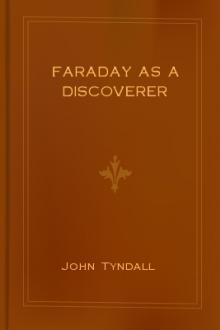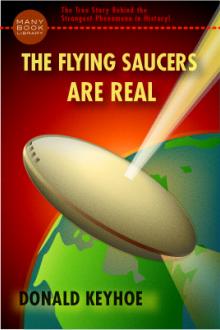Faraday as a Discoverer by John Tyndall (ebook reader with built in dictionary TXT) 📕

- Author: John Tyndall
- Performer: -
Book online «Faraday as a Discoverer by John Tyndall (ebook reader with built in dictionary TXT) 📕». Author John Tyndall
And now theoretic questions rush in upon him. Is this new force a true repulsion, or is it merely a differential attraction? Might not the apparent repulsion of diamagnetic bodies be really due to the greater attraction of the medium by which they are surrounded?
He tries the rarefaction of air, but finds the effect insensible.
He is averse to ascribing a capacity of attraction to space, or to any hypothetical medium supposed to fill space. He therefore inclines, but still with caution, to the opinion that the action of a magnet upon bismuth is a true and absolute repulsion, and not merely the result of differential attraction. And then he clearly states a theoretic view sufficient to account for the phenomena.
‘Theoretically,’ he says, ‘an explanation of the movements of the diamagnetic bodies, and all the dynamic phenomena consequent upon the action of magnets upon them, might be offered in the supposition that magnetic induction caused in them a contrary state to that which it produced in ordinary matter.’ That is to say, while in ordinary magnetic influence the exciting pole excites adjacent to itself the contrary magnetism, in diamagnetic bodies the adjacent magnetism is the same as that of the exciting pole. This theory of reversed polarity, however, does not appear to have ever laid deep hold of Faraday’s mind; and his own experiments failed to give any evidence of its truth. He therefore subsequently abandoned it, and maintained the non-polarity of the diamagnetic force.
He then entered a new, though related field of inquiry. Having dealt with the metals and their compounds, and having classified all of them that came within the range of his observation under the two heads magnetic and diamagnetic, he began the investigation of the phenomena presented by crystals when subjected to magnetic power.
This action of crystals had been in part theoretically predicted by Poisson,[2] and actually discovered by Plucker, whose beautiful results, at the period which we have now reached, profoundly interested all scientific men. Faraday had been frequently puzzled by the deportment of bismuth, a highly crystalline metal. Sometimes elongated masses of the substance refused to set equatorially, sometimes they set persistently oblique, and sometimes even, like a magnetic body, from pole to pole.
‘The effect,’ he says, ‘occurs at a single pole; and it is then striking to observe a long piece of a substance so diamagnetic as bismuth repelled, and yet at the same moment set round with force, axially, or end on, as a piece of magnetic substance would do.’
The effect perplexed him; and in his efforts to release himself from this perplexity, no feature of this new manifestation of force escaped his attention. His experiments are described in a memoir communicated to the Royal Society on December 7, 1848.
I have worked long myself at magne-crystallic action, amid all the light of Faraday’s and Plucker’s researches. The papers now before me were objects of daily and nightly study with me eighteen or nineteen years ago; but even now, though their perusal is but the last of a series of repetitions, they astonish me. Every circumstance connected with the subject; every shade of deportment; every variation in the energy of the action; almost every application which could possibly be made of magnetism to bring out in detail the character of this new force, is minutely described.
The field is swept clean, and hardly anything experimental is left for the gleaner. The phenomena, he concludes, are altogether different from those of magnetism or diamagnetism: they would appear, in fact, to present to us ‘a new force, or a new form of force, in the molecules of matter,’ which, for convenience sake, he designates by a new word, as ‘the magne-crystallic force.’
He looks at the crystal acted upon by the magnet. From its mass he passes, in idea, to its atoms, and he asks himself whether the power which can thus seize upon the crystalline molecules, after they have been fixed in their proper positions by crystallizing force, may not, when they are free, be able to determine their arrangement?
He, therefore, liberates the atoms by fusing the bismuth. He places the fused substance between the poles of an electro-magnet, powerfully excited; but he fails to detect any action. I think it cannot be doubted that an action is exerted here, that a true cause comes into play; but its magnitude is not such as sensibly to interfere with the force of crystallization, which, in comparison with the diamagnetic force, is enormous. ‘Perhaps,’ adds Faraday, ‘if a longer time were allowed, and a permanent magnet used, a better result might be obtained. I had built many hopes upon the process.’ This expression, and his writings abound in such, illustrates what has been already said regarding his experiments being suggested and guided by his theoretic conceptions. His mind was full of hopes and hypotheses, but he always brought them to an experimental test. The record of his planned and executed experiments would, I doubt not, show a high ratio of hopes disappointed to hopes fulfilled; but every case of fulfilment abolished all memory of defeat; disappointment was swallowed up in victory.
After the description of the general character of this new force, Faraday states with the emphasis here reproduced its mode of action: ‘The law of action appears to be that the line or axis of MAGNE-CRYSTALLIC force (being the resultant of the action of all the molecules) tends to place itself parallel, or as a tangent, to the magnetic curve, or line of magnetic force, passing through the place where the crystal is situated.’ The magne-crystallic force, moreover, appears to him ‘to be clearly distinguished from the magnetic or diamagnetic forces, in that it causes neither approach nor recession, consisting not in attraction or repulsion, but in giving a certain determinate position to the mass under its influence.’ And then he goes on ‘very carefully to examine and prove the conclusion that there was no connection of the force with attractive or repulsive influences.’ With the most refined ingenuity he shows that, under certain circumstances, the magne-crystallic force can cause the centre of gravity of a highly magnetic body to retreat from the poles, and the centre of gravity of a highly diamagnetic body to approach them. His experiments root his mind more and more firmly in the conclusion that ‘neither attraction nor repulsion causes the set, or governs the final position’ of the crystal in the magnetic field. That the force which does so is therefore ‘distinct in its character and effects from the magnetic and diamagnetic forms of force. On the other hand,’ he continues, ‘it has a most manifest relation to the crystalline structure of bismuth and other bodies, and therefore to the power by which their molecules are able to build up the crystalline masses.’
And here follows one of those expressions which characterize the conceptions of Faraday in regard to force generally:—‘It appears to me impossible to conceive of the results in any other way than by a mutual reaction of the magnetic force, and the force of the particles of the crystals upon each other.’ He proves that the action of the force, though thus molecular, is an action at a distance; he shows that a bismuth crystal can cause a freely suspended magnetic needle to set parallel to its magne-crystallic axis. Few living men are aware of the difficulty of obtaining results like this, or of the delicacy necessary to their attainment.
‘But though it thus takes up the character of a force acting at a distance, still it is due to that power of the particles which makes them cohere in regular order and gives the mass its crystalline aggregation, which we call at other times the attraction of aggregation, and so often speak of as acting at insensible distances.’
Thus he broods over this new force, and looks at it from all possible points of inspection. Experiment follows experiment, as thought follows thought. He will not relinquish the subject as long as a hope exists of throwing more light upon it. He knows full well the anomalous nature of the conclusion to which his experiments lead him. But experiment to him is final, and he will not shrink from the conclusion. ‘This force,’ he says, ‘appears to me to be very strange and striking in its character. It is not polar, for there is no attraction or repulsion.’ And then, as if startled by his own utterance, he asks—‘What is the nature of the mechanical force which turns the crystal round, and makes it affect a magnet?’…
‘I do not remember,’ he continues ‘heretofore such a case of force as the present one, where a body is brought into position only, without attraction or repulsion.’
Plucker, the celebrated geometer already mentioned, who pursued experimental physics for many years of his life with singular devotion and success, visited Faraday in those days, and repeated before him his beautiful experiments on magneto-optic action.
Faraday repeated and verified Plucker’s observations, and concluded, what he at first seemed to doubt, that Plucker’s results and magne-crystallic action had the same origin.
At the end of his papers, when he takes a last look along the line of research, and then turns his eyes to the future, utterances quite as much emotional as scientific escape from Faraday. ‘I cannot,’
he says, at the end of his first paper on magne-crystallic action, ‘conclude this series of researches without remarking how rapidly the knowledge of molecular forces grows upon us, and how strikingly every investigation tends to develop more and more their importance, and their extreme attraction as an object of study. A few years ago magnetism was to us an occult power, affecting only a few bodies, now it is found to influence all bodies, and to possess the most intimate relations with electricity, heat, chemical action, light, crystallization, and through it, with the forces concerned in cohesion; and we may, in the present state of things, well feel urged to continue in our labours, encouraged by the hope of bringing it into a bond of union with gravity itself.’
Supplementary remarks
A brief space will, perhaps, be granted me here to state the further progress of an investigation which interested Faraday so much.
Drawn by the fame of Bunsen as a teacher, in the year 1848 I became a student in the University of Marburg, in Hesse Cassel. Bunsen’s behaviour to me was that of a brother as well as that of a teacher, and it was also my happiness to make the acquaintance and gain the friendship of Professor Knoblauch, so highly distinguished by his researches on Radiant Heat. Plucker’s and Faraday’s investigations filled all minds at the time, and towards the end of 1849, Professor Knoblauch and myself commenced a joint investigation of the entire question. Long discipline was necessary to give us due mastery over it.
Employing a method proposed by Dove, we examined the optical properties of our crystals ourselves; and these optical observations went hand in hand with our magnetic experiments. The number of these experiments was very great, but for a considerable time no fact of importance was added to those already published. At length, however, it was our fortune to meet with various crystals whose deportment could not be brought under the laws of magne-crystallic action enunciated by Plucker. We also discovered instances which led us to suppose that the magne-crystallic force was by no means independent, as alleged, of the magnetism or diamagnetism of the mass of the crystal. Indeed, the more we worked at the subject, the more clearly did it appear to us that the deportment of crystals in





Comments (0)